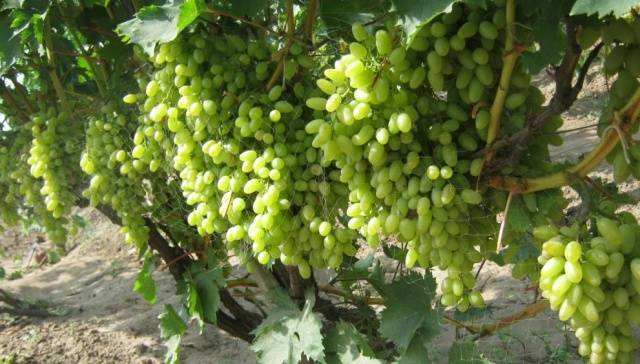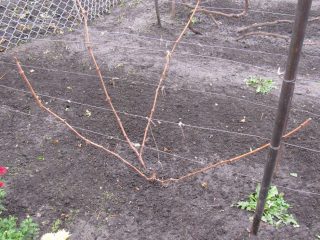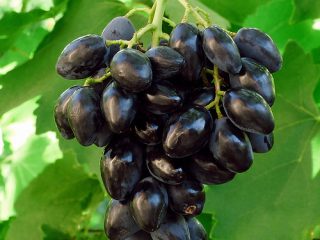Content
Breeders from all countries where grapes are grown are working hard to create delicious seedless varieties. One of the brightest successes of American winegrowers was the Century variety. In Russia it is also known under the English name Centennial Seedless. The variety was developed in California back in 1966 by crossing several vines: Gold x Q25-6 (Emperor x Pirovano 75). The variety received its place in the US registry only 15 years later. Kishmish has been actively distributed here since 2010.
The mid-early grape raisin Stoletie, according to the description and reviews of gardeners, is extremely popular due to its high marketability and excellent taste. When the international festival-competitions “Sunny Bunch” were held in Yalta, the variety was repeatedly awarded prizes as one of the best examples of seedless grapes.
Description
The medium-sized Stoletie grape bushes have a dark brown vine, strong, powerful, and fully ripen within a season. The grapes are not afraid of harvest load. Young shoots are greenish-brown. Five-lobed, medium-dissected leaves are intense green, large, with long petioles. A variety with bisexual flowers, pollinated well.
The raisin grape Centenary pleases with numerous large, not entirely dense clusters, weighing from 450 g to 1.5 kg.Under favorable conditions, the weight rises to 2.5 kg. The average weight is 700-1200 g. The shape of the grape bunch is cone-shaped.
Oval berries of medium size, 16 x 30 mm, light yellow or with a soft green tint. The weight of the berries of this raisin grape is uniform - 6-9 g. The berries of the Century are covered with a thin but dense skin that does not crack even when overripe. The smooth, crispy skin is easy to eat, and the sweet and juicy flesh gives pleasure with the harmony of taste and light nutmeg aroma. The Muscat flavor of this grape variety is more intense from the beginning of ripening, and then may be lost. This trait also varies depending on the composition of the soil where the vine is grown. In the south, according to local gardeners, delicate notes of tea roses are felt in the grape berries.
In reviews, winegrowers compare the taste of Century grapes with the more famous variety Kishmish Radiant. The level of sugars and acids is 15-16% and 4-6 g/l, respectively. There are not even small seeds in the berries of this grape.
Characteristic
Attractive bunches of sultanas grapes ripen 120-125 days from the beginning of the growing season, if the sum of the average daily temperature reaches 2600 degrees. You can enjoy Centenary berries immediately, from the beginning of September, or leave them for some time. The dense shell does not crack even under heavy rains, and the berries remain on the bunch until frost. The grapes take on a rich amber hue and accumulate sugar. The bunches of the Stoletie variety are not susceptible to peas.
Prolonged exposure of grape bunches to direct sunlight does not cause damage to the berries, but does affect the skin, which becomes covered with brown spots or a brown tan on one side.
Stoletie grape berries are suitable for drying - making sweet raisins. The variety is grown on a significant scale for this purpose, because the vines require minimal care with an excellent grape harvest.
The vine does not form stepsons, and after flowering the shoots grow slowly. The southern variety is not particularly winter-hardy, withstands frosts down to -23 0C. The Kishmish variety Century is sensitive to some fungal diseases.
Advantages and disadvantages
The advantages of the Stoletie raisin grape allow it to be grown in mass plantings in the southern regions of the country.
- Pleasant taste and versatility: fresh consumption and preparation of raisins;
- Stable high yield due to good pollination, volume and number of bunches;
- Excellent commercial properties and transportability;
- No need to standardize inflorescences;
- Resistance to gray rot;
- High survival rate of cuttings.
Among the disadvantages of the Stoletie raisin variety are:
- The need to thin out the berries to increase them;
- Short shelf life;
- Sensitivity to mildew and oidium;
- Susceptibility to phylloxera;
- Low frost resistance.
Growing
Century grapes are planted in autumn and spring in a place protected from northern winds, preparing the planting hole in advance.Northern and eastern slopes should be avoided; rows should be planned in a southerly direction. Groundwater must lie deep to prevent spring flooding of the site. The southern hybrid sultana Centenary is covered for the winter.
- On sandy loams, a hole measuring 0.4 x 0.4 x 0.6 m is sufficient;
- On heavy soils, depth is up to 0.7 m, hole 0.6 x 0.8 m;
- Drainage is laid below, then a thoroughly mixed top layer of soil with humus, compost and fertilizers: 500 g each of nitroammophoska and wood ash;
- You can use another option for planting minerals: 100 g of potassium sulfate and 150-200 g of superphosphate;
- After planting, abundant watering and mulching of the hole is necessary.
Watering
Century grapes, as gardeners indicate in reviews, require watering in the fall and spring to saturate the soil with moisture. During the flowering period, the grapes are also watered abundantly. Moisture after watering is retained with mulch, the soil is regularly loosened and removed. weeds.
Feeding
To obtain stable harvests, winegrowers must apply organic and mineral fertilizers to the Stoletie variety: a solution of bird droppings, wood ash, the “Crystallon” complex or other multi-component products. Plantafol will accelerate the ripening of the vine.
Trimming
For Centenary raisin grapes, it is better to carry out long pruning - by 6-8 buds, because the eyes near the base of the shoots do not bear fruit well. The best harvest is observed with a load of 35-40 buds and no more than 24 shoots. After flowering, gardeners remove several branches from the bunch, and thin out the berries before filling.
Treatment
Faded Stoletie grapes are sprayed against diseases with the drug "Ridomil-gold", and 3 weeks before ripening, "Topaz" is used.
Although the Centennial Vine requires attention, its exceptional yield will warm the heart of a keen gardener.
Vine with a similar name
Amateur gardeners should know that white table grapes New Century. This is a completely different variety, in no way related to the American vine that produces sultanas. The grapes are almost namesake, but, according to the description of the variety, the early ripening hybrid New Century was bred in the Ukrainian city of Zaporozhye. It is characterized by frost resistance, large-fruited and unpretentiousness, having inherited the best features from crossing the famous varieties Arcadia and Talisman. This variety also has the names New Century ZGTU and FVA-3-3.
The New Century vine is vigorous, bears male and female flowers, and is productive. Ripens in 4 months. The average weight of a bunch is 700-800 g, up to 1.5 kg. The berries are round, slightly oval, soft green-yellow in color; when fully ripe, they acquire an amber tint and tan on the skin. The pulp is sweet and contains 17% sugars. The grapes endure transportation.
On the shoots of New Century grapes, as gardeners write in their reviews, they leave 1-2 bunches without tearing off all the leaves for shading. The frost resistance of the vine is low: -23 degrees, with light shelter it tolerates -27 0C. Cuttings of the variety grafted onto winter-hardy grapes can withstand prolonged frosts. The grape hybrid is resistant to gray rot and is affected to a small extent by mildew and oidium, especially during the rainy season. Requires additional spraying at this time.














